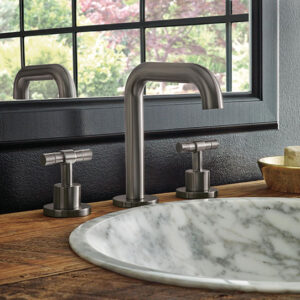Introduction
The decision between sensor (touchless) and manual faucets in commercial projects is more than aesthetics — it has a direct influence on hygiene, sustainability, maintenance, and customer experience. This research compares both systems from an architectural performance perspective, and how brands such as FontanaShowers and BathSelect are revolutionizing the future of commercial bathroom design.
What Are Sensor Faucets and How Do They Work?
Automatic or touchless faucets employ infrared or proximity sensors to detect hand movement and automatically turn water flow on. When hands move away, the flow cuts off immediately, minimizing waste. This process is explained in detail in the Automatic Faucet description on Wikipedia.
T&S Brass explains how infrared beams in the spout sense movement and trigger solenoid valves. They can be operated with battery, AC power, or even turbine/solar power, as Construction Specifier mentions.
Mechanical faucets come with manual handles or levers to operate the water, providing users with direct access to flow and temperature control.
Hygiene and User Experience
Sensor Faucets
Hygiene is one of the built-in benefits of touchless faucets. Since users never touch handles, risks of cross-contamination are reduced significantly. The Symmons Commercial Faucets Study highlights that sensor models minimize germ transmission, especially in high-turnover bathrooms.
The Chicago Faucets Facility Manager’s Guide refers to sensor faucets as the “safest option for occupants,” attributing decreased bacteria transmission and enhanced public trust in shared-use areas.
Touchless systems have the added advantage of a cleaner user interface, particularly in the case of children, the elderly, or accessibility-conscious areas, as detailed in the Symmons Application Guide.
Manual Faucets
Manual faucets, while dependable, are less sanitary with direct contact. Research such as the ArchitectU Restroom Hygiene Report demonstrates how faucet handles have the potential to re-contaminate otherwise clean hands. Manual faucets do provide fine temperature and tactile control, however, which would be beneficial in specific technical or laboratory environments.
Water Efficiency and Sustainability
Sensor Faucets
By far the largest architectural performance metric is water saving. Touchless faucets are naturally efficient since they offer automated shutoff capability. The Commercial Toilet Faucets Study found that sensor faucets conserve water by 35–60% compared to common manual taps.
Electronic faucets encourage hygiene while drastically reducing overall water usage — a godsend for LEED and WELL-qualified buildings, according to ArchitectU’s Sloan Analysis.
Manual Faucets
Manual faucets are likely to have larger flow rates and lack auto shutoff, which can contribute to higher water wastage. A review by The Splash Lab USA discusses that while manual models are cheaper, they may be less hygienic and require more maintenance.
Cost, Maintenance, and Lifecycle Performance
Upfront Costs
Sensor faucets cost more upfront on average — $150–$400, compared to $50–$150 for manual faucets, according to The Splash Lab comparison. Manual ones are easier to install, less complex, and best when budgets are tight.
Maintenance and Reliability
Touchless faucets have sensors, solenoids, and power systems to add complexity. Faulty installation or calibration can lead to false activation or failure, reports T&S Brass. Manual faucets, with fewer parts, generally require 25% less maintenance, states Access Bathroom’s performance study.
High-end models from Zurn, FontanaShowers, and BathSelect feature commercial-grade solenoids with hundreds of thousands of cycles anticipated, for improved reliability.
Total Cost of Ownership
While more costly in initial expenditures, sensor faucets typically provide better total cost of ownership (TCO) in the form of water and energy savings over time. Water and energy savings can recoup extra up-front costs within 12–18 months in high-use applications, the Commercial Toilet Faucets TCO Analysis states.
Architectural Design and Specification Insights
High-Traffic and Public Areas
Sensor faucets are ideal for shopping centers, airports, hospitals, and schools. The Chicago Faucets Facility Guide recommends their use in situations where maintenance effectiveness and cleanliness are essential. Power infrastructure (battery or wired) and sensor calibration to lighting levels must be factored into architecture, states Zurn’s Technical Overview.
Budget-Conscious or Low-Traffic Projects
In smaller clinics or private offices, however, there is still room for manual faucets. Their beauty, minimal upfront expenses, and ease of replacement make them reasonable where hygiene is not the main driver.
Design Aesthetics
Sensor faucets easily integrate with modern minimalist designs, eliminating bulky handles for a clean look. This is why FontanaShowers and BathSelect are widely specified by designers for luxury hotels and corporate settings. Manual faucets, conversely, add to traditional and classic designs with design flexibility.
Leading Brands Propelling the Market
FontanaShowers offers long lines of sensor faucets for commercial washrooms with emphasis on water conservation, ADA compliance, and unobtrusive design integration.
BathSelect supplies architect-quality touchless products with emphasis on low maintenance, brass durability, and infrared precision for heavy public usage.
Other worth-mentioning players include Chicago Faucets, Symmons, Zurn, T&S Brass, and The Splash Lab — all of which introduce water conservation and fixture innovation.
Conclusion
The sensor vs manual faucet debate in business architecture balances hygiene, efficiency, maintenance, and cost.
- Sensor faucets are perfect in hygiene-sensitive, heavy-use spaces and support sustainability and smart-building goals.
- Manual faucets continue to work for controlled environments or projects with limited budgets.
Lastly, the optimum solution depends on the volume of traffic, energy targets, and lifecycle cost targets in a given project. Forward-thinking brands like FontanaShowers and BathSelect showcase how future-proof design and technology can marry beauty and performance — changing the interaction architects have with water fixtures in modern commercial environments.

No responses yet